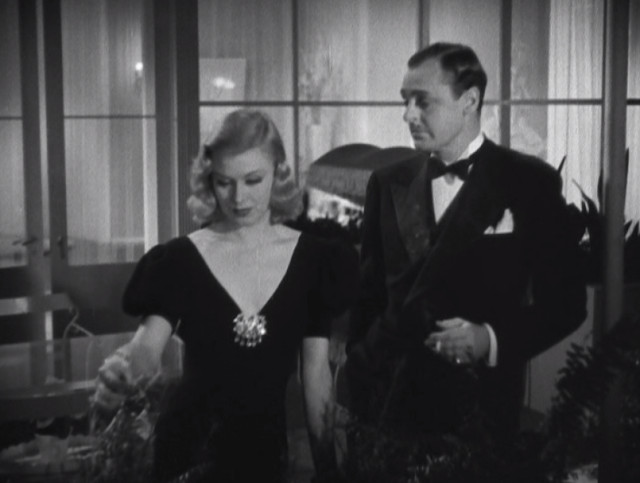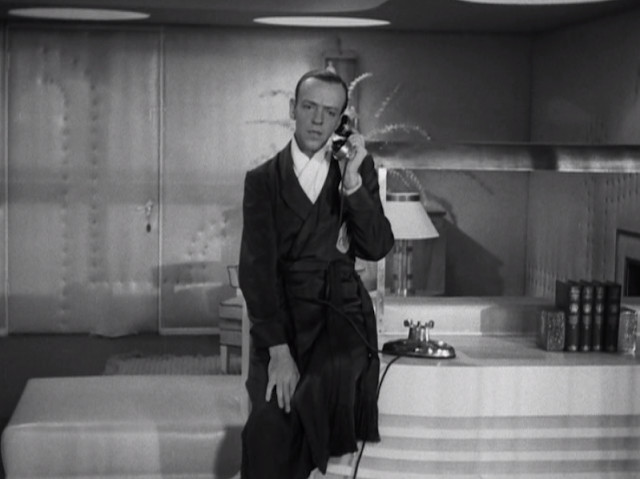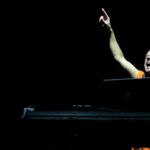When you delve into the filmography of the iconic duo Fred Astaire and Ginger Rogers, certain movies immediately spring to mind: Top Hat, Swing Time, and The Gay Divorcee. These are undoubtedly classics, but focusing solely on these highlights risks overlooking other dazzling entries in their repertoire. Among these often-underappreciated films is Shall We Dance, a 1937 musical comedy that deserves far more recognition. This effervescent and witty picture, brimming with George and Ira Gershwin’s phenomenal score, is a testament to the sheer joy and sophistication of the Astaire-Rogers magic. Let’s rediscover why Shall We Dance isn’t just another Fred and Ginger film, but a standout classic in its own right.
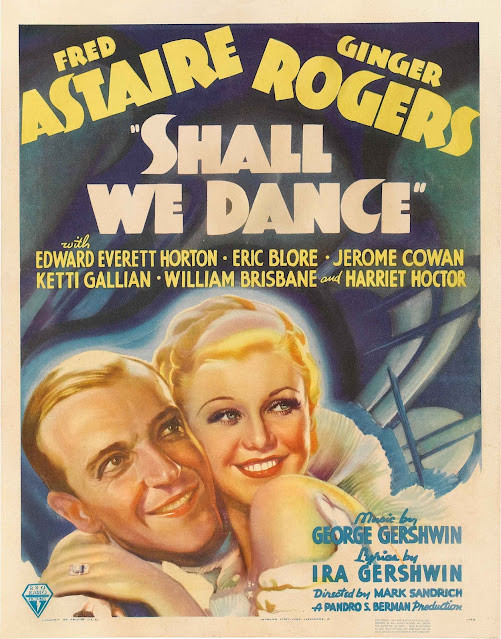
Promotional poster for the 1937 musical film “Shall We Dance” starring Fred Astaire and Ginger Rogers.
A Gershwin Masterpiece: The Music of Shall We Dance
One of the most compelling reasons to celebrate Shall We Dance is its exceptional score, crafted by the legendary George and Ira Gershwin. Despite their established fame and numerous hits, this was only the second film project for the brothers, and tragically, it became the sole Astaire-Rogers movie they ever worked on due to George’s untimely passing at just 38 years old. Shall We Dance gifted audiences with some of the Gershwins’ most beloved songs, alongside instrumental pieces composed by George, making it a truly unique musical experience within the Astaire-Rogers filmography.
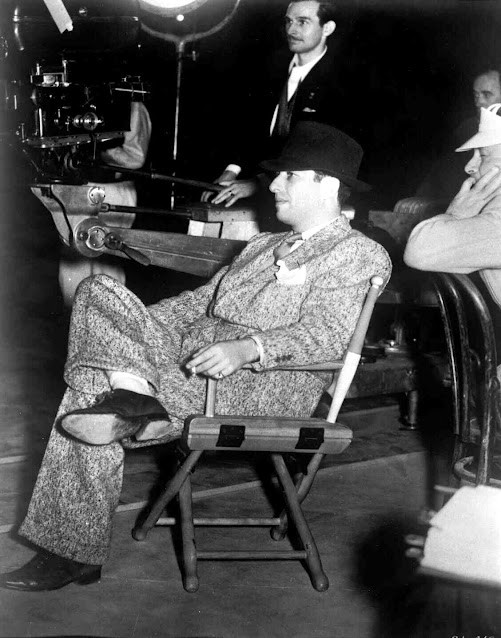
Director Mark Sandrich on the set of “Shall We Dance”, highlighting his collaborative role in the film.
Beyond the music, the brilliance of Shall We Dance is further amplified by its stellar cast and crew. Alongside Astaire and Rogers, the film boasts the comedic talents of Edward Everett Horton, the perpetually flustered Eric Blore, and a notable supporting performance from Jerome Cowan. Directing this delightful ensemble was Mark Sandrich, a frequent collaborator with Fred and Ginger, having helmed a total of five of their films, including the classic Holiday Inn with Astaire. But to truly appreciate the magic of Shall We Dance, we must delve into the story itself.
From Ballet to Tap: A Love Story Unfolds
Shall We Dance begins with striking Art Deco opening credits, setting the stage for the sophisticated era the film embodies. The scene opens in Paris, within a ballet company’s rehearsal space. Impresario Jeffrey Baird, played hilariously by Horton, observes the dancers, pleased with their performance – until he discovers his star, Petrov (Astaire), abandoning graceful ballet leaps for energetic tap steps. Petrov, whose given name is Peter Peters, has been captivated by the world of jazz. He expresses to a bewildered Jeffrey his desire to “combine the technique of ballet with the warmth and passion of” tap dance.

Fred Astaire as Petrov in “Shall We Dance”, showcasing his character’s initial ballet persona.
While Petrov’s newfound love for tap is genuine, there’s another, more romantic motivation behind his artistic shift: Linda Keene (Rogers). Linda is a celebrated tap dancer, and though they are yet to meet, Peter is already smitten. This infatuation sets the romantic comedy plot in motion.
Meanwhile, Linda is in her own world of celebrity frustrations. After a performance, her dance partner becomes overly amorous, a recurring issue for the famous dancer. Back in her apartment, Linda confides in her producer, Arthur (Cowan), about her exasperation with actors who “take the author’s lines literally.” Seeking a change, Linda decides to return to America and marry her fiancé, Jim Montgomery. Just then, Peter arrives at her door.

Ginger Rogers as Linda Keene in “Shall We Dance”, portraying her character’s glamorous stage presence.
Linda is initially unimpressed when the maid presents Peter’s card, asking dismissively, “What’s a Petrov?” Arthur, however, clarifies that Petrov is a ballet icon. Linda’s sarcastic reply, “That’s all I need to make things better — a simpering toe dancer!” sets the stage for their initial, comical clash.
Undeterred, Peter decides to play a character to get Linda’s attention. Adopting a ludicrous Russian accent and exaggerated ego, he bursts into her room, pretending to be the arrogant “great Petrov,” and comically orders Linda to “tweest.” Linda, trying to oblige, ends up embarrassing herself, which causes “Petrov” to storm out in mock impatience. Linda, bewildered and even more determined to leave, declares her eagerness to sail to New York the next day – a crucial detail Peter overhears.

Fred Astaire and Ginger Rogers in “Shall We Dance”, capturing their initial comedic encounter.
Back at the rehearsal hall, Jeffrey is meeting with Denise (Ketti Gallian), a former troupe member now seeking to rejoin after a wealthy marriage. Denise’s return is unwelcome for Peter, as she, much like Linda’s persistent partner, is relentlessly pursuing his affections. When Jeffrey re-hires Denise, Peter sees an opportunity. He makes a deal: if Jeffrey gets rid of Denise, Peter will agree to perform for the Metropolitan Ballet Company in New York, fulfilling Jeffrey’s long-standing wish. Unbeknownst to Jeffrey, Peter’s real motivation is to follow Linda to America.
Seasick Schemes and Shipboard Shenanigans
The next day, Peter is about to board his ship when Denise appears to see him off. During their conversation, she mentions Peter’s wife, making Peter realize Jeffrey has used the lie of a happy marriage to appease Denise. Aboard the ship, Linda is surprised to overhear Peter speaking to reporters and realizes she has been tricked. The charade crumbles when Peter slips back into his exaggerated Russian accent, leaving a confused Jeffrey wondering if he has caught a cold.

Ketti Gallian as Denise in “Shall We Dance”, portraying the character’s persistent nature.
Later, while his troupe rehearses, Peter finds himself drawn to the ship’s engine room. There, he joins a jam session with African-American workers to the rhythm of “Slap That Bass.” This scene is more than just a musical number; it represents Peter’s growing embrace of jazz and tap, moving away from the confines of ballet. His solo dance in the engine room beautifully illustrates this transition, blending balletic movements with jazz-inspired freedom, incorporating the sounds of the engine itself into the music.

Fred Astaire dancing with engine room workers in “Shall We Dance”, highlighting the “Slap That Bass” musical number.
The creation of “Slap That Bass” is an interesting anecdote in itself. While on the RKO lot, Astaire and choreographer Hermes Pan were inspired by the rhythmic sound of a cement mixer. They decided to integrate this unusual sound into the number. George Gershwin himself filmed Fred performing this number in color footage, a rare glimpse into the creative process.
Realizing Peter’s true motive for going to New York is Linda, Jeffrey is far from pleased. To distract his manager, Peter feigns seasickness, hilariously weaving around Jeffrey until he genuinely believes the ship is unstable. A thoroughly seasick Jeffrey stumbles into the cocktail lounge and collapses next to Arthur, who is already drowning his sorrows in champagne.

Edward Everett Horton and Eric Blore in “Shall We Dance”, showcasing their comedic pairing in the film.
The ensuing scene of drunken camaraderie between Jeffrey and Arthur is a comedic highlight. Edward Everett Horton’s portrayal of Jeffrey in Shall We Dance is arguably his funniest in his three Astaire/Rogers films. Despite his character’s occasional meanness towards Linda, Horton maintains a lovable silliness, ensuring we never truly dislike him.
Dog Walking and Budding Romance
On deck, Linda is walking her dog when she encounters Peter. This scene is underscored by George Gershwin’s instrumental piece “Walk the Dog,” a whimsical tune specifically written for the film at the composer’s insistence for more underscoring music. “Walk the Dog” perfectly captures the lighthearted mood as Peter, without a word, borrows a stranger’s dog to join Linda and attempt an apology for his Russian impersonation.

Fred Astaire and Ginger Rogers in “Shall We Dance” during the “Walk the Dog” sequence, highlighting their developing relationship.
Linda, however, remains resistant. The next day, another dog-walking encounter occurs, this time with Peter being dragged by a multitude of dogs, including Linda’s. Her resistance finally breaks down, and in the following scene, Linda and Peter are strolling arm-in-arm, engaged in cheerful conversation. When they stop for Linda to adjust her dog’s sweater, Peter expresses his disbelief at his good fortune in finding Linda. This tender moment leads into the song “Beginner’s Luck,” a lesser-known but charming Gershwin tune, perfectly capturing the blossoming romance.

Edward Everett Horton and Eric Blore in a comedic scene from “Shall We Dance”, adding to the film’s humorous elements.
Rumors and Rooftop Revelations
Inevitably, their newfound happiness is threatened. The manipulative Denise has spread rumors to reporters that she is traveling to America to visit “Mr. and Mrs. Petrov.” Given Linda and Peter’s recent closeness, everyone on the ship assumes Linda is the Mrs. Petrov in question. The rumor mill intensifies when gossipy passengers spot Linda knitting a dog sweater, misinterpreting it as a baby garment.

Ginger Rogers walking her dog in “Shall We Dance”, a scene that sparks shipboard gossip.
The fabricated news reaches the ship’s bulletin, much to the dismay of Jeffrey and Peter. “Why has this happened to me?” Jeffrey laments. “To you? It hasn’t even happened to me!” Peter retorts. When Peter discovers Denise is the source, realization dawns. He jokingly asks a flabbergasted Jeffrey, “Do you realize that you’re the father of my child?”
Peter insists Jeffrey must clear the air with Linda, threatening to cancel his Metropolitan performance otherwise. However, Jeffrey’s attempt at damage control backfires spectacularly. Instead of apologizing, he tells Linda that Peter has been using her to fend off Denise’s advances. Enraged, Linda arranges to fly to New York via mail plane, a wonderfully improbable, Old Hollywood touch.

Fred Astaire and Ginger Rogers in “Shall We Dance”, portraying a moment of developing affection.
Arthur, having learned of Jeffrey’s lie, and Peter confront the hapless impresario. But Jeffrey is too self-satisfied to care. When a fire drill interrupts them, Peter and Arthur seize the opportunity to prank Jeffrey, convincing him it’s a real fire and sending him scrambling to the lifeboats half-dressed and laden with ridiculous items – a satisfyingly funny revenge.
Mannequin Mishaps and a Jersey Nuptial
In New York, Linda meets with her fiancé, Jim (William Brisbane), to dispel the marriage rumors. Jim is deliberately portrayed as a weak and uninspiring love interest, highlighting that the film isn’t truly about a love triangle. Peter also arrives in New York and, by coincidence (or perhaps Cecil’s assumption), is placed in the suite next to Linda’s at the hotel.

Ginger Rogers and William Brisbane in “Shall We Dance”, highlighting the contrasting relationship with her fiancé Jim.
Jeffrey informs the hotel manager, Cecil (Eric Blore), that the marriage is fake. A flustered Cecil rushes to lock the connecting door between the suites, guarding Linda’s “purity.” That night, Arthur tries to lure Linda back to her rooftop club by offering to host her engagement party there, conveniently failing to mention Peter and Jeffrey will also be guests.
Arthur’s plan unfolds at the party. A spotlight shines on Linda, and the orchestra plays “They All Laughed,” compelling her to perform. The conductor then announces a surprise guest to dance with Linda… Peter! Peter, realizing Arthur’s scheme, takes to the stage, launching into balletic moves. Linda responds with tap, and to her astonishment, Peter matches her tap step for step in a delightful blend of dance styles.

A publicity still from “Shall We Dance”, showcasing the glamorous setting of the rooftop engagement party.
Inspired by their sensational dance partnership, Arthur intensifies the rumor campaign, hoping to sabotage Linda and Jim’s engagement. His assistant, Charlie, points out the lack of evidence for the marriage story. Arthur decides to fabricate some. Remembering a Linda mannequin intended for a scrapped number, Arthur and Charlie sneak into Peter’s room and stage a photo of the mannequin in bed with him.

Ginger Rogers in “Shall We Dance”, depicting Linda’s reaction to fabricated rumors and media frenzy.
The next morning, Linda is confronted with front-page photos of the scandal. Jim arrives, suggesting they postpone their engagement announcement. To avoid the press, Linda and Peter escape the hotel, attempting to go incognito in New York, albeit rather unconvincingly in sunglasses and hats, with Linda even wearing a monogrammed shirt.
Roller Skates and “Let’s Call the Whole Thing Off”
While roller-skating in Central Park, the pair’s forced proximity leads to bickering, which seamlessly transitions into the iconic song “Let’s Call the Whole Thing Off.” This comedic number perfectly highlights the contrasts between Peter and Linda – ballet versus tap, different pronunciations – becoming a metaphor for their relationship. The song’s genesis came from George Gershwin’s observation of Astaire and Rogers’ differing pronunciations of “either.”

Fred Astaire and Ginger Rogers on roller skates in “Shall We Dance”, performing the memorable “Let’s Call the Whole Thing Off” number.
Ginger Rogers herself claimed to have conceived the idea for the roller-skating number, noting how much fun it was to film with Astaire. Off-screen, she even hosted a roller-skating party attended by Hollywood luminaries like Cary Grant and Humphrey Bogart, showcasing the real-life fun inspired by the film.

Fred Astaire and Ginger Rogers in “Shall We Dance”, capturing the playful and iconic “Let’s Call the Whole Thing Off” scene.
Back in the film, Linda and Peter decide the only way to quash the rumors is to actually get married and then quickly divorced. They escape to New Jersey for a hasty ceremony. Meanwhile, Denise arrives at the hotel, determined to reignite her pursuit of Peter, unaware of the unfolding nuptials.
Divorce Papers and a Devastating Loss
Jeffrey, alerted to Denise’s arrival, instructs Cecil to stop her, revealing Denise as the rumor’s originator. Denise overhears, realizing the marriage is a sham, and her renewed pursuit of Peter becomes inevitable. On the ferry back from New Jersey, Linda and Peter somberly discuss their impending divorce. In a poignant moment, Peter sings the Oscar-nominated “They Can’t Take That Away From Me,” expressing his lasting feelings for Linda despite their temporary arrangement.

Ginger Rogers and Fred Astaire in “Shall We Dance”, capturing the emotional depth of the “They Can’t Take That Away From Me” scene.
This song held profound personal significance for Ira Gershwin. Following George’s sudden death shortly after the film’s release, Ira found solace and strength in the song, feeling it was George’s way of urging him to continue their musical legacy.
Back at the hotel, Cecil, confused by the marital status, seeks clarity from Linda, who confirms they are indeed married. Cecil, relieved, gives her the key to the connecting door. In a cleverly staged scene, the camera shows both Linda and Peter in their separate rooms, contemplating the connecting door. Linda inserts the key but hesitates, while Peter anxiously awaits her decision.

Publicity shot of Ginger Rogers and Fred Astaire for “Shall We Dance”, emphasizing the romantic tension between their characters.
Masks and a Grand Finale
However, the anticipated romantic reunion is interrupted by Denise, who bursts into Peter’s room with renewed determination. Linda, witnessing this, puts on a brave face and firmly tells Denise they are married and not divorcing. Denise, recognizing Linda’s resolve, departs, but Linda, heartbroken, leaves the hotel. Peter, overjoyed by Linda’s “no divorce” declaration, is crushed to find the connecting door locked again and Linda gone.

Ginger Rogers and Fred Astaire in “Shall We Dance”, depicting a moment of dramatic tension in the plot.
Arthur reveals his mannequin scheme to Peter, and Jeffrey delivers more bad news: the Metropolitan has cancelled Peter’s performance due to the scandal. With both star and showless, Peter and Arthur decide to collaborate and quickly begin rehearsals for their own production.
On opening night, Linda appears with Jim and her lawyer, intending to serve Peter divorce papers. As she watches the show, she realizes Peter’s performance is a dance portrayal of their relationship. It begins with ballet, representing his life before Linda, with Peter in his ballet costume, subtly modified to blend ballet and tap styles.
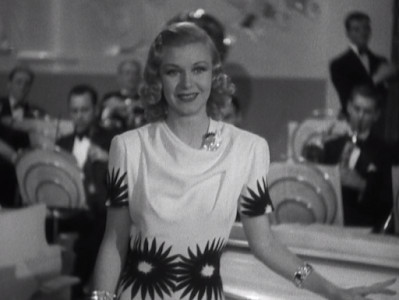
Edward Everett Horton and Fred Astaire in “Shall We Dance”, showcasing their characters’ dynamic in the film.
Ballerina Harriet Hoctor represents Denise, while a chorus line of tap dancers wearing Linda Keene masks represents Linda. Arthur explains Peter’s mask concept: “if I can’t dance with one Linda, I’ll dance with dozens.” Despite Ginger Rogers’ own discomfort with the masks, Linda is touched by Peter’s gesture, realizing his true feelings.
Linda goes backstage and replaces one of the masked dancers. Onstage, she reveals herself, and after a moment of humorous confusion among the masked Lindas, Peter finds the real one. They complete the number together, leading to a happy resolution.
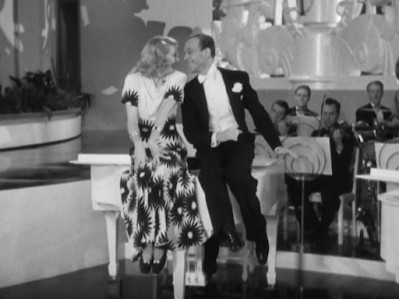
Fred Astaire and Ginger Rogers dancing together in the finale of “Shall We Dance”, symbolizing their romantic and artistic union.
From Stage to Screen: The Genesis of Shall We Dance
Interestingly, Shall We Dance was initially conceived by Rodgers and Hart as a film vehicle for Astaire titled On Your Toes. When Astaire declined, it became a Broadway show, featuring “Slaughter on Tenth Avenue.” The show’s success inspired RKO to pursue a ballet-themed film, leading to Shall We Dance. While both share ballet and jazz themes, the similarities are minimal, making Shall We Dance a unique entity.

Ginger Rogers and Fred Astaire performing “They All Laughed” in “Shall We Dance”, a key musical and dance sequence.
Shall We Dance was initially intended to be the final Astaire-Rogers collaboration. However, RKO recognized their enduring appeal and paired them again in Carefree, and later The Story of Vernon and Irene Castle, seemingly concluding their partnership. Yet, a decade later, Ginger reunited with Fred for The Barkleys of Broadway, providing a fitting final chapter to their legendary on-screen journey.
The Gershwins and the Magic of Fred and Ginger
The Gershwins’ connection to Astaire and Rogers predates Shall We Dance. Ginger Rogers’ breakthrough came with their Broadway show Girl Crazy, where she introduced “Embraceable You.” Fred Astaire even consulted on the choreography for that show. Ginger and George Gershwin also shared a personal friendship, and even a brief romantic connection.
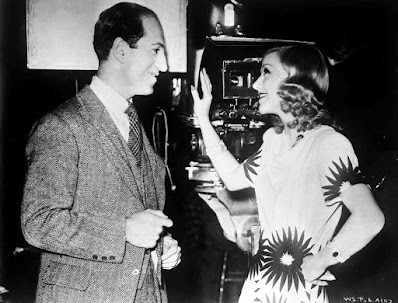
Ginger Rogers and George Gershwin, illustrating their personal and professional connection.
Fred Astaire’s history with the Gershwins was even longer, starting in the 1920s with Gershwin shows featuring Fred and his sister Adele. Fred introduced many of their hits, including “Fascinatin’ Rhythm.” After Shall We Dance, while Fred and Ginger pursued separate projects, Fred again worked with the Gershwins on A Damsel in Distress. Tragically, during this time, George Gershwin’s health declined rapidly, and he passed away shortly after. His last words were reportedly Fred’s name, a testament to their close bond.
A Timeless Classic: Why Shall We Dance Still Shines
Shall We Dance is more than just a musical comedy; it’s a remarkable film that showcases the best of Fred Astaire and Ginger Rogers. With its witty screenplay, unforgettable Gershwin score, dazzling dance numbers, and an exceptional supporting cast, Shall We Dance remains a cinematic delight. It’s a film that deserves to be rediscovered and celebrated for its sparkling charm and timeless appeal. If you’re looking for a classic Hollywood musical that will lift your spirits and leave you wanting to dance, Shall We Dance (1937) is an absolute must-see.

A montage of scenes from “Shall We Dance” (1937), showcasing the visual richness and dance sequences of the film.




























